Did Cnn Lighten The Skin Of The Bomber
Its development was kept under wraps for 14 years, but by 1991,the F-117 Nighthawk had become a household word.
Television viewers who tuned to the Cablevision News Network (CNN) on the evening of January xvi, 1991, were treated to a rare live preview of wars to come. Correspondents Bernard Shaw and Peter Arnett, broadcasting live from their room in Baghdad's Al-Rashid Hotel, were roofing the state of alert of Saddam Hussein's Republic of iraq.
5-and-a-one-half months afterwards Iraqi forces invaded the emirate of State of kuwait–and 17 hours subsequently the borderline for their withdrawal set by the coalition opposing them–Baghdad had taken shelter beneath the strongest concentration of air defenses in the earth. These included 76 surface-to-air missile (SAM) launchers and nearly three,000 anti-aircraft artillery (AAA or triple-A) guns.
Iraqi radar operators scoured the moonless skies for the first indication of budgeted aircraft, simply they saw nothing. "We haven't heard any planes nevertheless," noted Shaw, wondering aloud whether Boeing B-52 bombers flew then high they couldn't exist heard.
Six hundred and fifty miles almost due s, at Khamis Mushayt in southwestern Kingdom of saudi arabia, U.Southward. Air Force pilots of the 37th Tactical Fighter Wing too were glued to the CNN newscast. 2 hours earlier, some of their squadron mates had departed King Khalid Air Base in the first airstrike of the war. I of their targets, located on the west bank of the Tigris River, was the 370-pes Al-Kark Communications Tower, which transmitted CNN's television signal to the outside world. Now, as the estimated time on target approached, each human at Rex Khalid kept i eye on CNN and the other on his sentry, counting downward. If all had gone co-ordinate to schedule, the network would become off the air…now!
The demand for an shipping that could penetrate mod air-defence force systems had actually arisen from another Eye Eastern conflict most 20 years earlier. In the 1973 Yom Kippur State of war, Israeli-flown McDonnell-Douglas F-4 Phantom fighters suffered heavily from Egypt's radar-guided SA-vi SAMs. In Vietnam, meanwhile, the U.Southward. Air Force was devoting more than half its aircraft to radar suppression rather than bombing. The first real solution to these problems would not come up until 1975. It came from the well-nigh likely source, the Advanced Projects Division of Lockheed-California–the famous "Skunk Works." Engineers there reasoned that curved surfaces reverberate energy in many directions, the way a soap bubble reflects sunlight. If an shipping'due south surfaces were apartment, like the facets of a diamond, reflections could exist limited to directions of the designers' pick–namely, abroad from enemy receivers. Models tested outdoors at Lockheed's Palmdale facility bore out the hypothesis–even a bird atop one model caused its radar cross-department (RCS) to overstate or to "bloom."
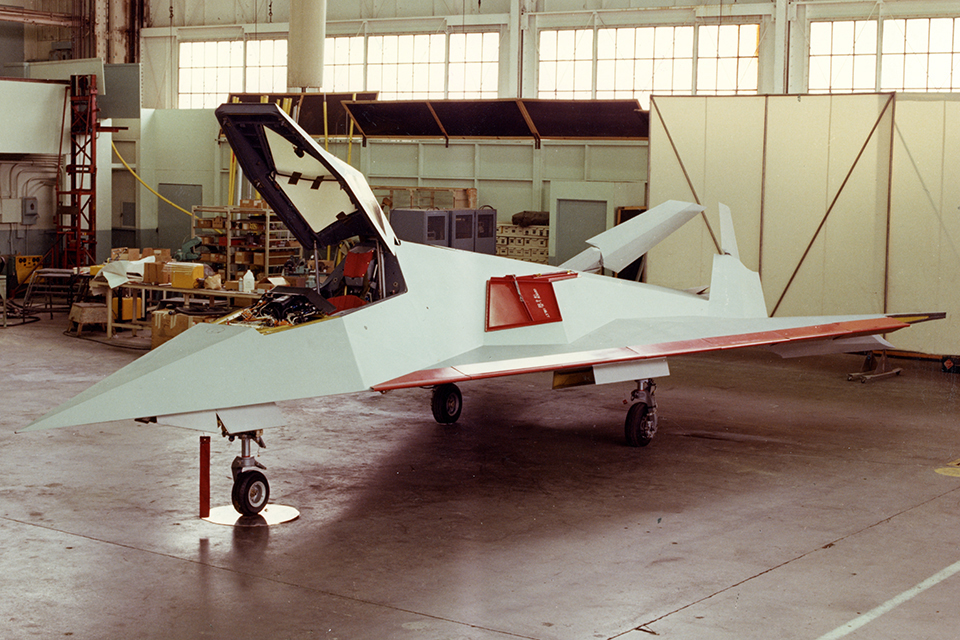
But faceting acquired treatment problems for pilots, then Skunk Works team leader Ben R. Rich–a close acquaintance of Lockheed'south brilliant engineer Kelly Johnson and a veteran of the firm's U-ii and SR-71 spy plane programs–secured government funding of two full-sized, flight prototypes nether the appropriately meaningless code name "Have Blue." Skinned with flexible radar-absorbent cloth (RAM), they featured sharply swept wings with twin fins canted sharply in, not for supersonic capability just to avoid billowy reflected signals back to their source. For the same reason, doors for the cockpit awning, the access panel and the landing gear were given jagged, sawtooth edges that had to fit perfectly flush when airtight.
The mere reflection of the pilot's helmet would outshine the rest of the plane put together, so the canopy was besides given a transparent coating to render it impenetrable to radar. Similarly, considering modern radars can expect downwardly engine inlets to bounciness returns off the highly reflective compressor blades (and in many cases identify them by counting the rotating blades), the two engine inlets were covered with a fine, radar-opaque mesh. Screw heads were redesigned because at one betoken just iii screws that had been insufficiently tightened caused the jet's RCS to blossom.
Radar, withal, is not the only popular method of shipping detection. To reduce their vulnerability to heat-seeking missiles, the prototypes used slit-similar exhausts, shielded from beneath by a broad, flat, "platypus" tail. Exhaust emerged in cool, diffuse fans rather than hot, concentrated streams. The canted fins also were intended to screen the engine exhausts from enemy fighters looking down from above.
The prototypes were shipped to the top-secret facility at Groom Dry out Lake, in the Switzerland-size Nellis Air Force Range n of Las Vegas, Nev. Home to both the U-2 and SR-71 testing programs–as well equally the "Blood-red Hat" squadron, the height-surreptitious stable of captured MiG fighters–Groom Lake was the natural choice for the Air Force's newest "black" (peak-secret) program.
The first prototype flew in early 1978. Naturally unstable and made airworthy just by virtue of computerized, quadruple-redundant, fly-by-wire controls, it exhibited rapid speed loss in nose-up attitudes, a loftier landing speed and a high sink charge per unit. These problems ultimately proved its undoing when Lockheed test pilot Bill Park bounced it off the footing, jamming the correct gear halfway upward. Unable to country or even abdomen in, he burned off the backlog fuel and ejected at 10,000 feet over the Nevada desert. The prototype was destroyed, and Park, injured during the ejection, never flew once again.
The second prototype, notwithstanding, was a success, proving for all practical purposes its invisibility to radar. Information technology showed at most a low-intensity, nebulous radar sparkle that was most duplicate on a radar scope from background noise until the aircraft was well within a basis missile's minimum launch range. Only the massive airborne antenna of the Boeing E-3 Spotter AWACS (airborne warning and control system) and some ground-based low-frequency and very-loftier-frequency radars had success detecting it, but because of their large antennas the latter ii are unsuitable for battlefield apply.
Considering the plane offered virtual immunity to radar, the Air Force quickly underwrote production of total-scale development (FSD) aircraft. The new design reflected lessons learned during the Take Blue program. Engine power was increased. The inlets and exhausts were baffled and soundproofed to minimize noise–emitting, instead of the typical jet turbine scream, a high-pitched whine said to set dogs barking before the plane appeared in the sky. The prototypes' inward-canted fins had actually acted to reverberate the exhausts' oestrus emissions, so the FSD'southward fins were canted outward in a V-shaped "butterfly" tail.
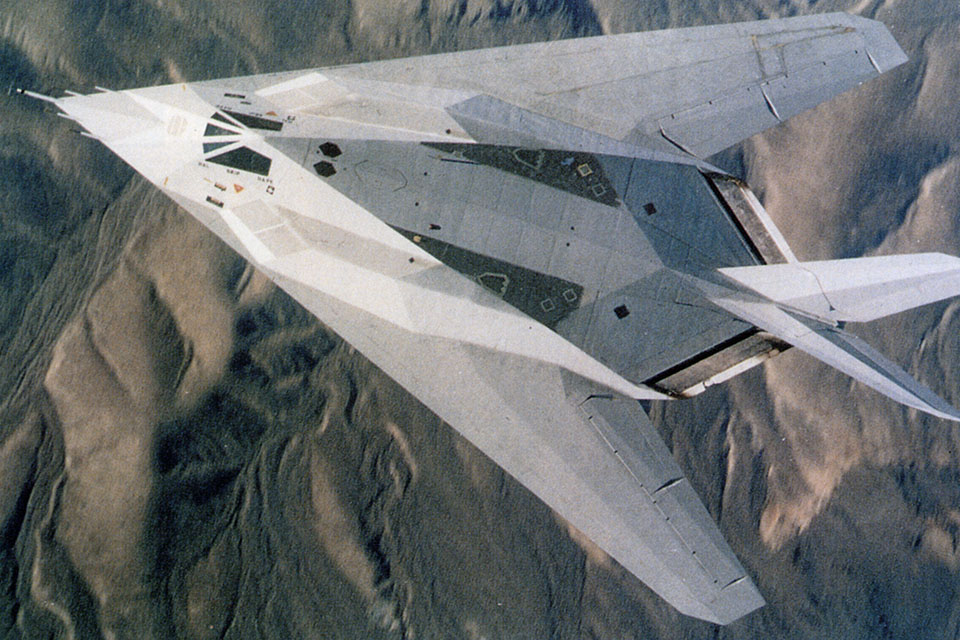
The demands of gainsay, as modified by the requirements of stealth, dictated the rest of the redesign. Contrary to most military aircraft designs since the 1950s, the airplane would carry no radar, since fifty-fifty an inactive radar acts as a reflector. Even the normal radio antennas that beautify conventional aircraft were fabricated to retract beneath the aeroplane's skin when non in utilise.
Also, since external fuel tanks and weapons would adversely affect the aeroplane'due south RCS, all fuel and munitions would exist carried internally. The limited capacity of inboard fuel tanks could be overcome with aerial refueling. Instead of carrying tons of conventional bombs, the airplane would bear simply ane or ii laser-guided "smart" bombs. Substantially comprised of a seeker head and fins attached to a standard "dumb" bomb, smart bombs home in on invisible, infrared laser light shined on the target by the attacking aircraft. The result is a "circular-error probable" (CEP: the circular altitude effectually the target in which the bomb is likely to strike), measurable in inches.
The Air Forcefulness was broken-hearted for a new aircraft, having (temporarily) lost its new Boeing B-one bomber to government cutbacks. Naturally, speculation in the aviation press centered effectually a total-sized, advanced-technology bomber. The new plane might have escaped attention altogether, except that in 1980 the White House intentionally alluded to its existence. Whether this was an election-twelvemonth ploy remains open to question. The new shipping–then popularly known as the "stealth fighter" rather than the "stealth bomber"–was to become a hot aviation topic over the next decade.
The new airplane was given a new code name, "Senior Trend," besides equally the deceptive designation of F-117. The American "Century Series" of fighter aircraft, beginning with the N American F-100 Super Sabre, supposedly ended with the General Dynamics F-111 Aardvark. In October 1962, in the interest of cantankerous-service commonality, the Section of Defense began renumbering its combat aircraft, starting with F-i. Later the Northrop YF-17 (which became the Northrop/McDonnell-Douglas F/A-18 Hornet) came the Northrop F-twenty Tigershark. Aviation journalists naturally guessed the stealth fighter was designated F-nineteen to fill in the numbering void. The origin of the F-117 designation is somewhat of a mystery, merely information technology began turning upwardly on Lockheed documents regarding Senior Tendency, and the Air Force saw no reason to change it. At the very to the lowest degree, it enabled government spokespersons to plausibly deny the existence of an F-19.
The first stealth fighters were flown by Lockheed C-five Galaxy cargo plane to Groom Dry Lake, where they took to the air for the outset fourth dimension in June 1981. Security was, to put it mildly, tight. Unauthorized ground personnel were required to remain indoors when a stealth jet emerged from its hangar. Test flights were made mostly at nighttime, their schedule arranged to avert overflights past Soviet reconnaissance satellites. The Nellis Range is as well home to the Air Force'south "Ruby Flag" air combat exercises, which involve aircraft and pilots of American and several strange military aviation services. Those other aircraft were kept away from the Groom area by an airborne screen of security aircraft.
Despite the F-117'southward 33 pct increment in concrete size over the prototype, the stealth fighter'due south RCS measured between .01 and .001 square meters–about that of a small bird. For instance, compared to a McDonnell Douglas F-4G Phantom typically used for "Wild Weasel" anti-radar missions, which has a head-on RCS of 6 meters, the F-117 was able to get xc pct closer to basis-based search radars, and 98 per centum closer to airborne radars, before being detected.
Testing was still underway when the Air Force ordered an unabridged wing of the product version of Senior Trend, the F-117A Nighthawk. Until delivery of their F-117As, the pilots trained in Vought A-7D Corsair IIs. The first military airplane pilot to fly a Nighthawk was Lt. Col. Alton C. Whitley, a Vietnam veteran with gainsay experience in the A-vii and the North American F-100, and quondam commander of the Air Force's "assaulter" squadron. "When I beginning looked at [the F-117A]," he recalls, "it reminded me of some 'Star Wars' blazon of shipping. I thought, 'Boy, is this the 21st century!'"
Having outgrown the Groom Lake facilities, the stealth unit–now officially the 4450th Tactical Grouping–operated out of the remote Tonopah Test Range airfield in the northwest corner of the Nellis Range. Although overlooked by public land, the Tonopah facility was some twoscore desert miles from the nearest town–sufficiently remote to discourage all simply the well-nigh persistent observers. Pilots of the 4450th flew into Tonopah each Mon aboard a government-chartered airliner for four nights of training before returning abode on Friday afternoon.
By this fourth dimension the second Have Blue prototype had caught fire in midair and crashed, and the kickoff F-117A had been retired later on going inverted and backward on takeoff. Both exam pilots survived. The start incident was attributed to a broken fuel line, and the 2d to inadvertently cross-connected pitch and yaw controls. (Normally the Nighthawk'south fly-by-wire organisation compensated for its instability so well that when ane jet lost an entire rudder at high speed, the pilot had to be informed of the fact by the chase plane, after which he landed safely.)
With depression wing loading and G limits comparable to that of the F-iv, the F-117 reportedly handles well. The widely publicized nickname "Wobbly Goblin" manifestly derives from its "departure" characteristics–one time out of control, it cannot exist recovered.
In June 1986 and once more in Oct 1987, pilots flew their Nighthawks into the ground. Both incidents were attributed to pilot fatigue and disorientation. Despite U.South. Air Force efforts to the contrary, word filtered to the outside world. Public interest in the stealth fighter had been renewed in July 1986, when Testor Corporation released a curvaceous plastic model of an "F-19," insisting it was lxxx percent accurate.
Finally, in Nov 1988, the Pentagon publicly revealed a grainy, retouched photo notable mostly for how little information technology revealed of the F-117. Past then, the 4450th, now activated as the 37th Tactical Fighter Wing (the "Defenders of the Crossroads") and consisting of the 415th and 416th Tactical Fighter squadrons (the "Nightstalkers" and "Ghost Riders," respectively) and the 417th Tactical Fighter Training Squadron (the "Bandits"), was gainsay-set up. Twice, stealth fighters were within an hour of taking off to bomb targets in Great socialist people's libyan arab jamahiriya, only to take their missions scrubbed to avoid revealing their existence. Non until December 1989 and the U.Due south. invasion of Panama–Operation Simply Crusade–did the F-117A see action.
Refueling in midair, vi Nighthawks fabricated their way to Panama via Texas and the Caribbean Sea. Two of these were fill-in aircraft, which turned back unneeded. Two more than were assigned to support special forces troops attempting to kidnap Full general Manuel Noriega, merely their mission was scrubbed.
Defoliation over the terminal-minute change resulted in a mix-up over the remaining target, a barracks housing two battalions of aristocracy enemy troops. The intent was non to impale but to stun; the pb F-117A did only that with a unmarried 2,000-pound Marker 84 bomb. Colloquially known equally "the Hammer," the flop–with a lethal radius of 400 feet and capable of bravado out eardrums half a mile away–exploded in a field next to the billet, throwing the Panamanians into confusion. The second stealth jet likewise hit its aim signal, which, all the same, turned out to exist in error. Still, the Air Force declared the mission a success. After all, the stealth jets had gone unnoticed on Panamanian radar.
On August 17, 1990, the 37th Tactical Fighter Wing received a new commander–Colonel Al Whitley. "Four hours later," the colonel recalls, "the word came in to deploy our outset squadron." The United States and its allies planned to oust Saddam Hussein's Iraqis from Kuwait, by forcefulness if necessary, and the Nightstalkers were among the first allied units to deploy to Saudi arabia.
Located half-dozen,500 feet upward in the mountains near the Red Sea, King Khalid Air Base — nicknamed "Tonopah East"–had been congenital in the belatedly 1970s in return for commitment of McDonnell-Douglas F-15 Eagle fighters and AWACS airborne sentries to Saudi Arabia. Because the base was well across the achieve of Iraqi Scud-B ballistic missiles, the stealth jets would crave three midair refuelings each in society to reach their master target–downtown Baghdad.
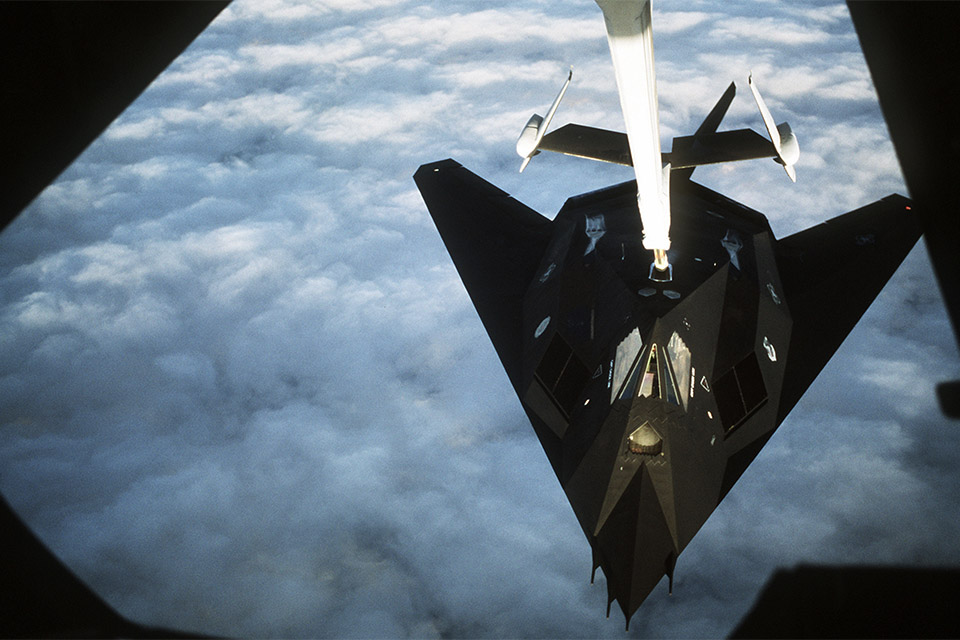
"I more often than not put the F-117s against the Baghdad targets," stated the Air Force'south chief mission planner, Brig. Gen. Buster C. Glosson, "where we would have lost [conventional] airplanes." Mission personnel included only three combat veterans–Whitley, his deputy commander, and one Only Cause pilot. But five months after the F-117s were deployed to Saudi Arabia the incessant preparation above the barren Nevada desert paid off. The Nightstalkers and Ghost Riders lugged 2 tons of bombs apiece across more than ane,000 miles of dark desert. Soon before iii a.m. local time, January 17, 1991, eight black jets arrived, lights out and radio silent, higher up Baghdad.
It was Captain Marcel Kerdavid who was assigned to bomb the Al-Kark belfry. "Fifty-fifty though I felt very well prepared with my training, I was somewhat apprehensive about the shipping," he admitted later. "Its stealthiness had not been tested in combat, and everyone wondered whether or non this stealth stuff really worked."The New 'Stealth Fighter'?
Does the U.S. military take a new "black" shipping plan in the works? Since the mid-1980s, the aviation press has been investigating Pentagon paper trails and bystander encounters with what may be the stealth fighter of the next century.
Listed (perhaps accidentally) in a February 1985 Pentagon budget asking along with Lockheed's SR-71 Blackbird and U-ii spy planes, the projection'south code proper noun, "Aurora," may take been intended as a ruse similar to the F-nineteen ploy–it had been practical to a maritime patrol aircraft developed for the Canadian armed services. But the Canadians had already taken delivery of their Auroras, and the Pentagon was plain withal developing its Aurora–to the tune of $80 meg in financial 1986, increasing almost thirtyfold to about $2.three billion by 1987.
Typically, the Air Forcefulness had no annotate. Only by 1988 it was reportedly at work on a replacement for its SR-71 reconnaissance aircraft, which information technology retired with uncharacteristically little reluctance in March 1990. What kind of aircraft could brand the SR-71'due south Mach iii-plus cruise and 80,000-foot ceiling obsolete? Artists' conceptions, some perhaps purposely misleading, depict super-Blackbirds weighing in at more than 150 tons, powered by variable-wheel turbo-ramrockets burning liquid marsh gas or even liquid hydrogen, cruising the border of space at Mach 6. According to bystander accounts, Aurora is more modest, in size if not performance.
In early 1990, Aviation Week and Infinite Technology magazine reported incredibly loud air traffic at night over Edwards Air Forcefulness Base in California. 1 source described the sound as "the heaven being ripped open." In June 1991, a sonic smash similar to those caused by space shuttles re-entering the atmosphere–and strong enough to register on seismographs–rolled across Southern California. Judging by its sonic "footprints," the object was flight toward the huge Nellis Air Force Range at more than Mach iii.
Activeness too seems to center around the air base at remote Machrihanish in western Scotland (which was linked to the F-117A before the Nighthawk was fabricated public). In Nov 1991, for instance, a Royal Air Force air traffic controller observed a radar blip depart Machrihanish at Mach 3. And in August 1989, on the other side of Scotland, an engineer on an oil rig in the Northward Sea observed a midair refueling operation involving a mysterious plane shaped, when seen from below, like an isosceles triangle.
A new Blackbird spy plane? A futuristic superfighter? A prototype supersonic transport, or even an aerospace plane to supersede the space shuttle? Only one affair is certain–design teams like the Skunk Works never rest on their honour. D.H.
Anticipating a pilot-rattling sleet of anti-shipping fire, mission planners had assigned a 2d stealth jet to mark Kerdavid's target and lighten his workload. (In fact, the prior arrival of several Tomahawk cruise missiles had spurred a flurry of triple-A, merely a few minutes before the stealth jets arrived overhead the Iraqi crews actually ceased burn to cool their guns.) Every bit the laser beam touched the Al-Kark's dome-shaped roof, a frontwards-looking infrared radar (FLIR) scope in the nose of Kerdavid'southward plane picked up the signal and displayed it in the cockpit's 8-inch video display. Using a fingertip command on his throttle stick, Kerdavid locked his aim bespeak onto the laser glint, and his weapons system projected an imaginary "basket" above it, into which information technology would have to drib the bomb for a successful strike.
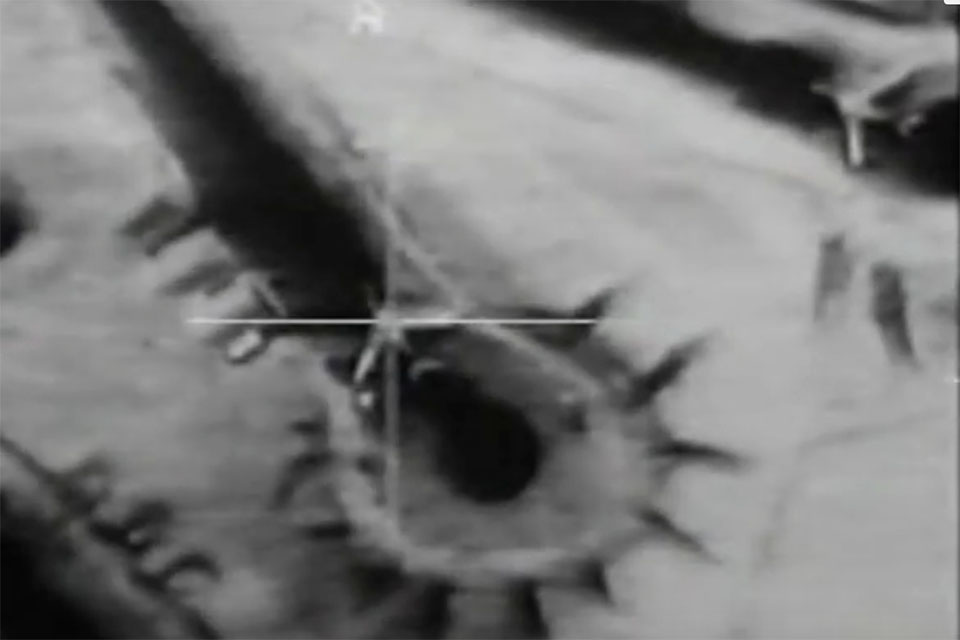
10 seconds before release, Kerdavid hit the "pickle" button that enabled his weapons system. The Nighthawk's bomb bay snapped open up and lowered its lethal load into the slipstream: a 1-ton GBU-27A/B guided bomb, designed especially for use past the F-117A.
Freed of the necessity of dodging anti-shipping burn, Kerdavid (who received the Silver Star for his feat) was able to drib his bomb from relatively high above and near the Al-Kark. He immediately veered abroad northward toward his secondary target, a control bunker in the Taji suburbs. The 2nd F-117 loitered on station a little longer, using its abdomen-mounted, downward-looking infrared radar (DLIR) laser designator to mark the target for Kerdavid'southward flop as it brutal.
In their room in the Al-Rashid Hotel, the CNN reporters' microphones picked upward the ascension moan of an air raid warning. "Now the sirens are sounding for the first time," noted Peter Arnett. "The Iraqis have informed us…."
At that instant, as if out of nowhere, Kerdavid'due south GBU-27 slammed into the Al-Kark, drilling halfway downwardly the tower before exploding. The entire building snapped in half–a spectacle lost to CNN viewers and personnel at Male monarch Khalid because the network promptly went black. A surviving audio-only land link allowed Arnett to verbally draw the blinding spray of bumming render fire ascension above the Baghdad skyline. The Iraqi gunners' radars told them no aircraft were above them.
Seconds later another F-117A's GBU-27 hit straight across the Tigris from the Al-Kark. It fell through the roof of the 12-story Baghdad International Telephone Exchange, known to Air Force mission planners as the "AT&T Edifice" and the only target in the metropolis slated for a double hit. I of those planners was the 415th Tactical Fighter Squadron's Major Jerry Leatherman, who threescore seconds after the first strike circled in from the northeast to drop a pair of high-blast Mk. 84 homers from three miles up through the hole in the building'south roof. The commencement went a little low, but the 2nd was dead on, and together they demolished the tiptop 4 floors.
In quick succession, three waves of stealth jets singled out their objectives with a precision at once merciful and merciless–the Iraqi Air Force and Ba'th Party headquarters, air defense control centers, Rashid Airfield, and other loftier-value targets including 2 of Saddam Hussein's presidential palaces. A one-half-hr afterward the initial attacks, the city blacked out, probably not because of Iraqi precautions but because the power grid was destroyed. Just Baghdad remained well lit past the triple-A fire.
Back at Rex Khalid, the ground crews anxiously counted the returning aircraft, the terminal of which did non touch down until after dawn. Miraculously, not just did every Nighthawk come dorsum, but none of them bore so much every bit a scratch.
In the start 24 hours of the war, the 42 stealth fighters at King Khalid–simply 2.v percent of the total allied aircraft deployed in the Gulf–accounted for 31 percent of the targets attacked. Impairment estimates were lower than expected, partly due to a low layer of mist that obscured Baghad toward dawn. Not but did deject cover–three times the seasonal boilerplate during the course of the war–interfere with subsequent operations, it compromised the blackness jets' invisibility.
"If you're only above a cloud deck, with the moon reflecting off it, yous can really stick out," explained Leatherman. At one indicate, an F-117A was shadowed by what appeared to be an Iraqi Dassault Mirage F1 fighter, shining a landing low-cal or spotlight in club to visually acquire the stealth jet. A gentle turn, however, broke whatsoever lock the Iraqi had; that was the closest any Nighthawk came to a dogfight over Iraq.
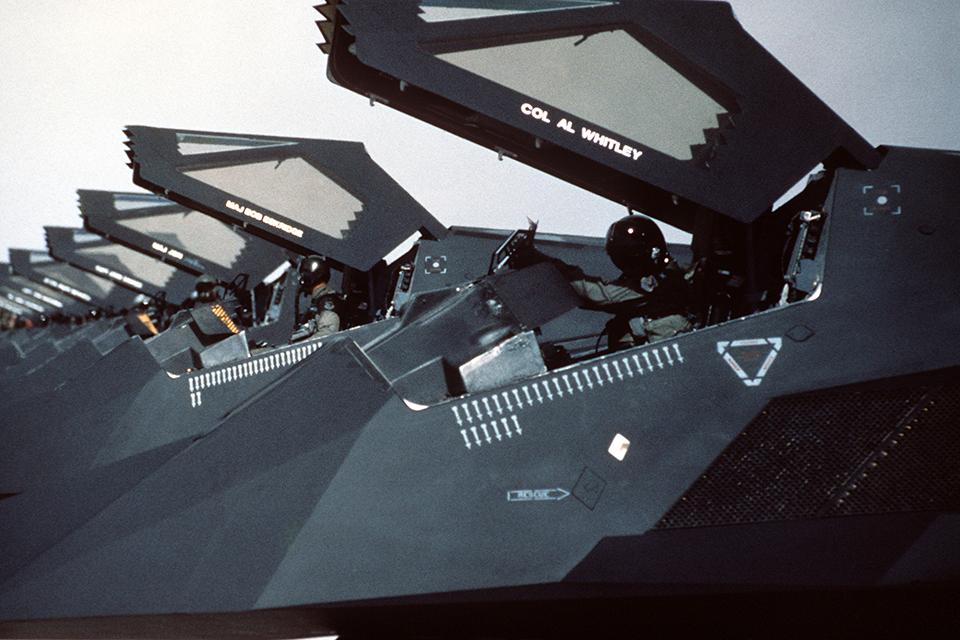
The black jets were consistently assigned the most dangerous, high-priority targets throughout the Gulf War. These included radar sites, SAM and Scud launchers, enemy command/control/communications facilities, bridges, hardened aircraft shelters, and bunkers. Their data recorders provided some spectacular video footage for Air Force publicists. These included a hardened Scud storage facility destroyed past a laser-guided bomb dropping through an air duct; ane bomb blowing in the door of an ammunition bunker and a 2d bomb flying through to explode inside; and a GBU-27 flight down an elevator shaft to detonate deep within the Iraqi Air Strength headquarters, blowing out all four walls.
Ultimately the greatest purpose served past Nighthawks' surgical strikes, equally opposed to indiscriminate bombing, was the saving of lives on both sides. Past successfully handling more than than 40 percent of the coalition forces' strategic targets, the F-117s convinced the U.S. Air Strength to brand significant changes later on the war in order to accommodate to the new engineering science and tactics.
The 37th Tactical Fighter Wing, redesignated the 49th Tactical Fighter Fly, relocated from Tonopah to Holloman Air Strength Base of operations, N.M. Air Strength analysts have so far plant no way stealth technology can be compromised in the foreseeable future. In whatever case, the F-117A Nighthawk, the Skunk Works and Ben Rich are assured their places in aviation history. "We guaranteed to evangelize an shipping which would have stealth characteristics, be virtually undetectable past today's known radar technologies, and be able to deliver a weapons arrangement with unprecedented accuracy," said Rich. "We've washed that. Our accomplishments speak for themselves."
Don Hollway of York, Pa., writes frequently for Aviation History. For additional reading: Stealth, past Doug Richardson; Desert Tempest Air War, by Robert F. Dorr; and Aurora: The Pentagon'south Secret Hypersonic Spyplane, by Beak Sweetman.
The story was originally published in the March 1996 issue ofAviation History Magazine. For more great articles subscribe today!
Is it time to build an F-117 for your collection? Click here!
Source: https://www.historynet.com/stealth-secrets-of-the-f-117-nighthawk-mar-96-aviation-history-feature/
Posted by: scotthings1958.blogspot.com

0 Response to "Did Cnn Lighten The Skin Of The Bomber"
Post a Comment